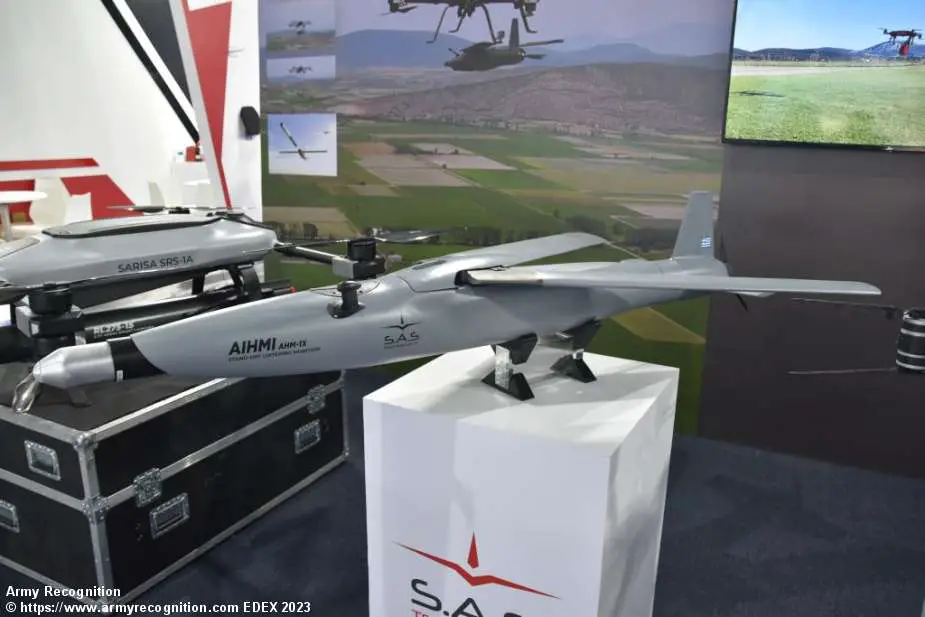Breaking news
EDEX 2023: Greek company SAS Technology displays Aihmi AHM-1X 70mm loitering munition.
At EDEX 2023, Spirit Aeronautical Systems (SAS Technology), a Greek company established in 2020, presented its Aihmi AHM-1X, an unmanned aerial system (UAS) developed to extend the range of 2.75-inch (70mm) rockets. The company considers the Aihmi AHM-1X as a potential weapon for its Sarisa SRS-1A weaponized drone, which completed a second test in July 2023, armed with 70mm rockets.
Follow Air Recognition on Google News at this link
 The Greek Aihmi AHM-1X loitering munition is armed with a 70mm rocket (Picture source: Army Recognition)
The Greek Aihmi AHM-1X loitering munition is armed with a 70mm rocket (Picture source: Army Recognition)
The initiative behind SAS Technology's Aihmi AHM-1X project aimed to enhance the safety of both manned and unmanned platforms armed with rockets on the battlefield. This response addresses the increasing threat to helicopters and UAVs posed by advancements in very short-range air defense systems and the deployment of vehicles with more potent cannons. These developments, coupled with counter-UAS systems, have rendered guided or unguided rockets vulnerable to ground-based air defenses, even at the tactical level. To meet this challenge, SAS Technology collaborated with Thales to develop an airframe to increase the range of 2.75-inch rockets.
The resulting system, named Aihmi, spearhead in Greek, takes the form of a UAS with a high wing featuring an electric motor at the back that activates a two-blade pushing propeller. Optionally, it can function as a glider without any propulsion system. The distinguishing feature is the insertion of a 2.75-inch (70mm) rocket into the UAS fuselage at the front. The entire system measures 1.82 m in length, with a wingspan of 1.98 m. Before launch, wings fold back along the fuselage and extend just after launch. The overall weight is 16 kg, with a 12 kg payload represented by the 70mm rocket itself, and the airframe is predominantly made of carbon fiber, notable for its potential radar signal absorption, enhancing stealth capacities.
The engine battery allows for a 15-minute powered flight at speeds up to 140 km/h, after which the system transitions into a gliding approach. The glide ratio is between 13 and 15, depending on the launching altitude over the ground. Guidance is provided by a GPS/inertial system.
If fitted with a guided munition, the Aihmi AHM-1X utilizes a reflected laser beam from a third-party illuminator in the final phase. At this point, the warhead is armed, and once inbound, typically within 7 km from the target, the rocket is fired, leaving behind the carbon fiber airframe and expelling the rear electric motor. The rocket then travels towards the hit point, with a standard circular error probable (CEP) of less than 1 meter.
For unguided rockets, the Aihmi follows a similar trajectory, allowing the operator to select the target using a two-way datalink. The silent approach, when the electric motor has completed its function, minimizes errors associated with unguided rockets.
According to the company, when launched from an altitude of 1,000 m over the ground, the Aihmi AHM-1X in the powered version will cover 45 km before initiating a 15 km gliding approach, placing the system in the Stand-Off Loitering Munition (SOLM) category. In its glider-only mode, the range is reduced to 15 km from the same altitude.
SAS Technology considers the Aihmi AHM-1X as a potential weapon for its SRS-1A Sarisa weaponized drone, which has a 25 kg payload capacity, enabling it to carry one Stand-Off Loitering Munition (SOLM), while its Thalos II fixed-wing UAS can accommodate up to four AHM-1X.


























